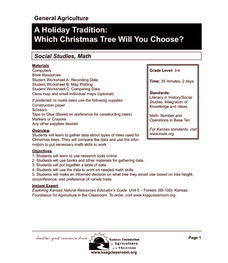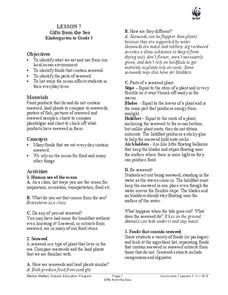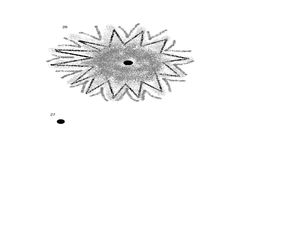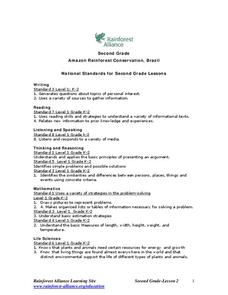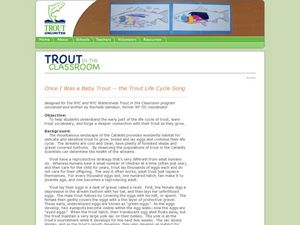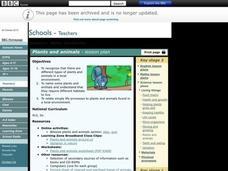Curated OER
Feeding Frenzy
Young biologists take a look at the myriad of ways that animals increase their chances of surviving in the wild. The adaptations help animals hide, hunt, and attract a mate. This lesson specifically explores how insect mouth parts are...
Curated OER
Giant Smelly Plant Attracts Thousands
Read and discuss a news article about a rare corpse plant that bloomed in Washington D.C. Because this native Indonesian plant blooms so rarely, people flock to see it. After reading the article, your class answers comprehension...
Agriculture in the Classroom
A Holiday Tradition: Which Christmas Tree Will You Choose?
Different varieties of Christmas trees provide an interesting way to combine social studies, science, math, and technology. Class members not only research the history of the Christmas tree holiday tradition, they compare and...
Core Knowledge Foundation
Ecology Tell It Again!™ Read-Aloud Anthology
A read-aloud anthology provides informational texts about ecology to boost reading comprehension. Third-graders listen and discuss readings where they answer questions and focus on vocabulary. Pupils complete extension activities,...
Curated OER
Terrariums: A Look at the Living and Nonliving World
Third graders examine life in a terrarium and relate it to life in a larger environment. In this terrarium lesson, 3rd graders examine how living and non-living things work together by examining the changes in a terrarium. They make...
Curated OER
Bye-Bye Trout Song
Students develop an understanding about what will happen to trout after they are released into the trout stream. In this trout life lesson, students discuss how it feels to release the trout they have cared for. Students also sing a song...
Curated OER
The Great Horned Owl
In this recognizing facts about the Great Horned Owl worksheet, students read fun facts, match illustrations with adaptations, sequence life cycle cards, and read what to do if they find an injured bird. Students solve 16 answers.
Curated OER
Food Chain Game
Students explore animal characteristics by participating in a role-play activity. In this food chain lesson, students discuss the order of life and how animals must eat other animals to survive. Students conduct a food chain game in...
Curated OER
Writing a Fly Report
In this science research worksheet set, students complete scaffolded worksheets as they prepare to write a report about flies. They research information about the habitat, life cycle, interesting facts, diets, and predators of flies,...
Curated OER
Big Boas of Manu
Students investigate the Boa Constrictor and other snakes of the Peruvian rainforest of Manu. They watch and discuss a video, color and construct life-size paper snakes, conduct research, and write a science journal reflection.
Curated OER
Ways To Go Green
In this environmental awareness worksheet, learners learn how to "go green" by reading 10 tips that can be used in everyday life. Students answer 10 multiple choice questions. This is an online interactive worksheet.
Curated OER
Do You Know How an Amphibian Grows?
In this amphibian growth worksheet, students fill 5 blanks with the correct cut-and-paste image of the stages of growth from tadpole to adult frog. Students cut out each stage of growth and order them in the life cycle of a frog.
Curated OER
Electrical Appliances
Learners explore electricity in daily life by examining everyday appliances. In this electrical current activity, students identify the differences between watts, volts and amps and how they relate to the devices we depend upon. Learners...
Curated OER
Cycling Water Through the Environment
Students identify the ways in which water moves through our environment and consider the different forms it can be found in. They view videos, conduct experiments and participate in class discussions. Students determine the role that...
Curated OER
Gifts from the Sea
Students discover the oceanic food chain. In this healthy eating lesson, student investigate the fish we eat and the food the fish eat. Students discover what ocean animals eat seaweed and what everyday foods we eat that also...
Curated OER
Hold It
Young scholars explore animal characteristics by examining water currents in person. In this animal strength lesson, students discuss tides and currents and attend a field trip in which they are in contact with flowing water. Young...
Curated OER
Animal Wordsearch
In this science worksheet, students examine 25 words in a word bank; all are names of fish and sea creatures. Students locate the words in a word search puzzle.
Curated OER
Green Plants
Beginning botanists are introduced to the world of plants with this PowerPoint. Some of the information is most appropriate for primary learners, such as the needs of a plant. Some of the information, however, is more directed at...
Curated OER
A Peek into the Lives of Stars!
Students create a model of the birth of a star and demonstrate the stages of the star's lifecycle. In this star lifecycle instructional activity, students mix flour and water in a jar to model the birth of a star, then role-play...
Curated OER
Animal Characteristics
Students investigate the characteristics of animals by creating a chart. In this animal life lesson, students create a KWL chart listing all the different animals a class can name. Students take a field trip to a science facility to get...
Curated OER
Seed Structure and Seed Dispersal
Third graders plant seeds. In this seed structure lesson, 3rd graders identify parts of a seed and plant a lima bean seed. Students discuss and reflect on the process in their journals.
Curated OER
Amazon Rainforest Conservation, Brazil
Students explore the concept of understanding the effects of disturbances in an environment. In this life science lesson, students use the game Jenga to help capture the idea of environment disturbances. Students discuss the...
Curated OER
Once I Was a Baby Trout
Learners sing a song about the trout life cycle. In this trout life cycle lesson plan, students learn trout vocabulary and make motions while singing this song.
Curated OER
Plants and Animals
Students discuss the different types of plants and animals in a local environment. In this science lesson, students name some plants and animals understanding that they require different habitats to live. Students use computers to...


